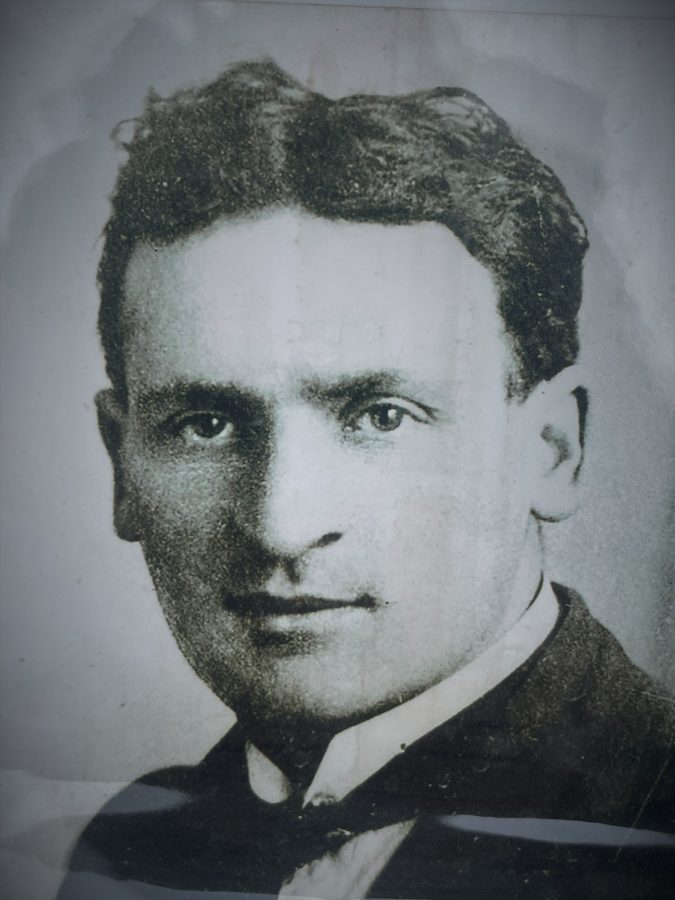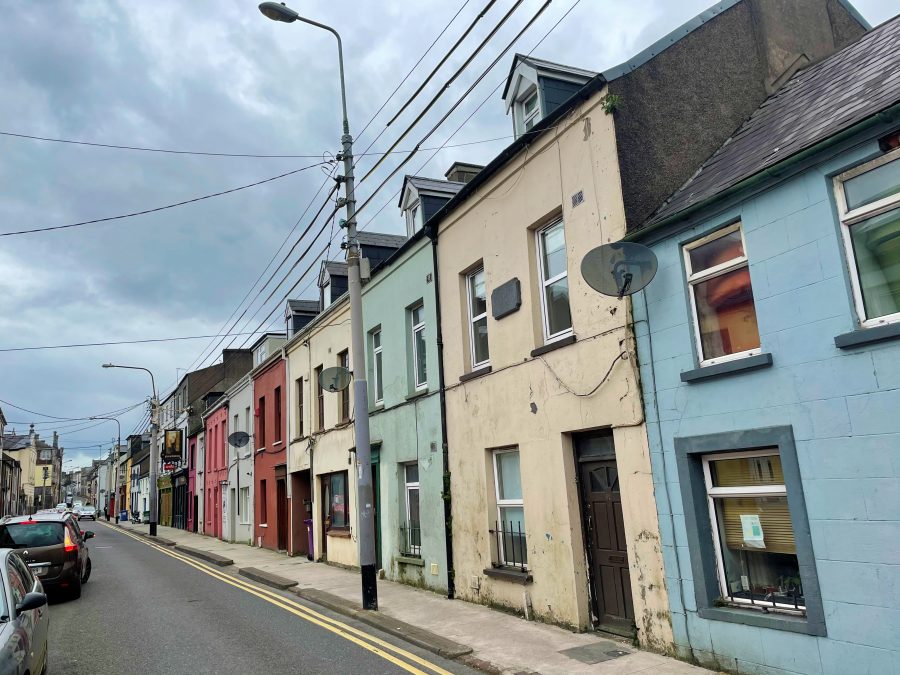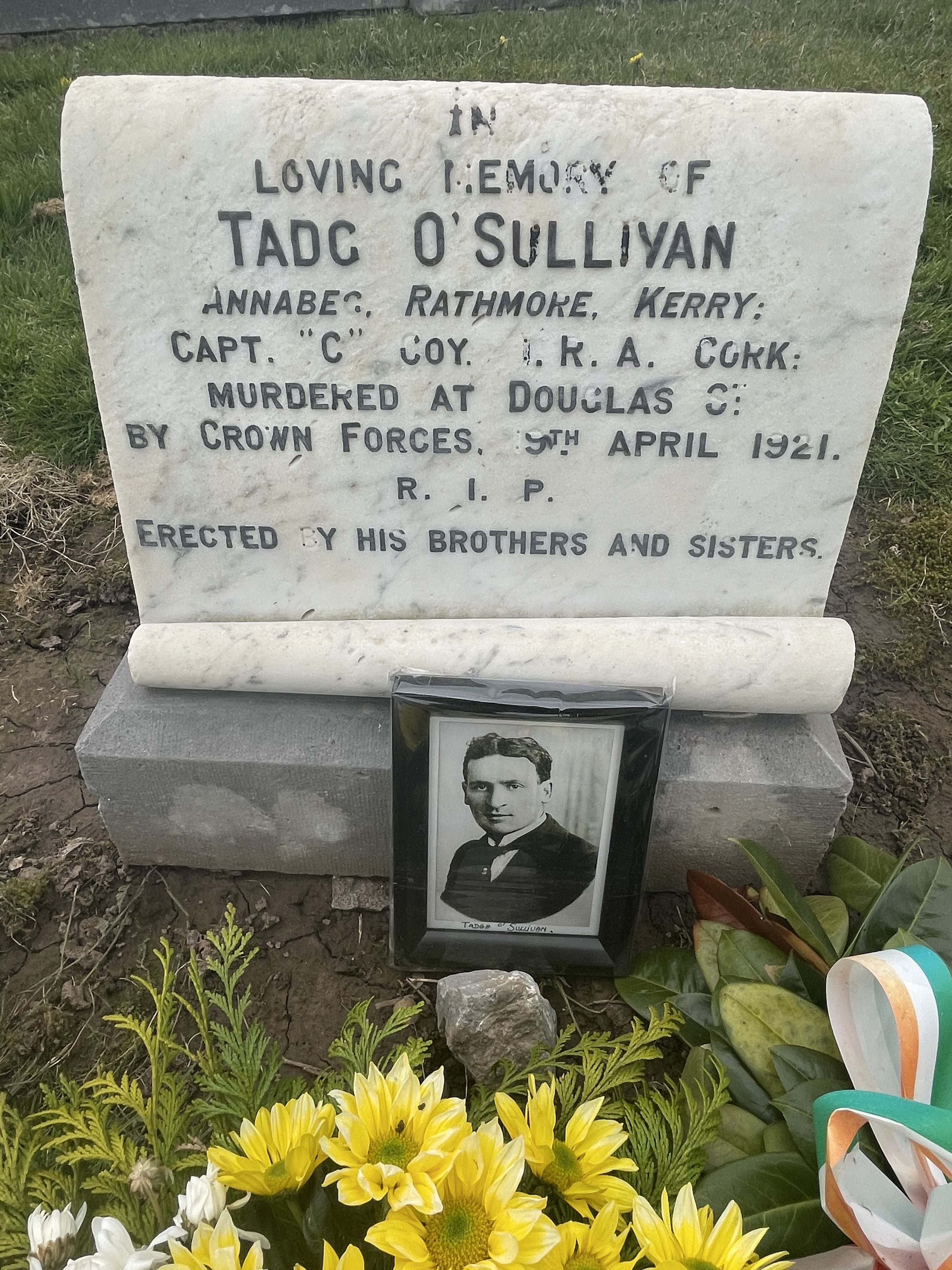
Kieran’s Our City, Our Town Article,
Cork Independent, 22 April 2021
Journeys to a Truce: The Ambush of Tadhg O’Sullivan
Targeted round ups of IRA members by the RIC and Black and Tans continued right throughout April 1921. Company Captain within the 2nd Battalion, Cork City No.1 Brigade and Kerry native, Tadhg O’Sullivan was shot on the evening of 19 April 1921. Originally Tadhg was reared on a farm north of the village of Barraduff, County Kerry and was passionate in the study of Irish being inspired by his national school teacher. In his teens, he set off for Cork City, where he was employed on the clerical staff of Messrs Dowdall O’Mahony, butter merchants. Later he transferred to Fords.
Tadhg joined the IRB and enrolled as a Volunteer. He took an interest in the organisation of the Fianna – the youth section of the Volunteer movement. He was active in organising recruitment meetings throughout the county.
Tadhg eventually rose to becoming Captain of C Company, 2nd Battalion, Cork No.1 Brigade. He was constantly on duty and participated in many major operations in the City. He was one of the two Kerry men on the inquest jury of the murdered Lord Mayor of Cork, Tomás MacCurtain. Florence O’Donoghue was the other Kerryman. In the summer of 1920, Tadhg participated in the attack on Farran RIC Barracks and also in the Barrack Street ambush on 9 October 1920. He was again to the fore in the Parnell Bridge ambush, which took place on 5 January 1921. He was also one of the Belfast hungers strikers in 1920. Tadhg was also one of those taken in the big round-up at Cork Union hospital. However, he was released on that occasion.
Michael Murphy, Commandant, 2nd Battalion, Cork No.1 Brigade in his witness statement to the Bureau of Military History (WS 1547), describes of Tadhg’s death on 19 April 1921:
“One of my best company captains named Tadhg Sullivan was held up in Douglas Street by two British intelligence officers in mufti. He made a dash to escape and got into a house No. 80 Douglas St. He ran upstairs and got out on the roof through a landing window, closely followed by the two British officers. Sullivan got on to the roof of the adjoining house when the officers appeared at the landing window and shot him dead. He was unarmed”.
The Cork Examiner on 20 April 1921 describes that the tragic occurrence took place in the course of a general roundup in the south and south-west side of the city, which began about 7pm. Numerous parties of police from Union quay and Tuckey street stations visited the district, which they practically enveloped up to Friar’s Walk and Barrack Street.
At 7.30pm pedestrians coming from every point converging on the district were held up, questioned and searched, and about fifteen persons were temporarily detained, one man, Liam Barry, residing in White street, was arrested.
The extensively drawn cordon gradually closed in towards Douglas Streetvicinity. There was quite a large number of passersby, and amongst them, was Tadhg. He was observed by a party of about eight or nine police. They called on him to halt, but instead he started to run away, whereupon the police pursued.
As he ran a short distance along the street Tadhg seems to have escaped the bullets of his pursuers, and then he was seen to suddenly dash into a house. The police by this time were reinforced by a second party of constables, coming from an opposite direction. Tadhg was followed into the house – the hall and stairway of which bore the marks of considerable firing. Cornered as he was, Tadhg made a desperate effort to escape, and rushing into a back room, endeavoured to get away through a back window.
Tadhg was in the act of descending into the yard below, which offered an avenue of escape, when he was overtaken by his pursuers and shot dead. His dead body with several bullet wounds was subsequently found in the yard below. Fr McSweeney, CC, St Finbarr’s South, and Fr Father Nunan, CC, were immediately summoned, but on their arrival Tadhg had already passed away.
Tadhg’s remains were then conveyed to Union Quay Barracks, and afterwards transferred in a military lorry to the Victoria Barracks, where the circumstances of his death were to be the subject of an inquiry.
On the afternoon of 22 April 1921, Tadhg’s funeral took place from the South Chapel to St Finbarr’s Cemetery where they were interred in the Republican plot. The cortege was limited in extent by order of the military and armed soldiers walking on foot at both sides of the hearse, in three lorries, and accompanied by anarmoured car. The order was served on the Administrator of the parish about one hour before the funeral was timed to start was obeyed. Despite the warnings, the streets from the church – over Parliament Bridge, along the South Mall, Grand Parade and Washington Street – were lined with people. The coffin was draped in the tricolour flag.
Have a story of relative to tell involved with the War of Independence in Cork, get in touch with Kieran at mccarthy_kieran@yahoo.com
Captions:
1096a. Portrait of Tadhg O’Sullivan, c.1921 (source: Cork City Library).
1096b. House of Tadhg O’Sullivan’s death, second from the right with plaque above front door (picture: Kieran McCarthy).
1096c. Gravestone of Tadhg O’Sullivan, St Finbarr’s Cemetery, present day (picture: Kieran McCarthy).

